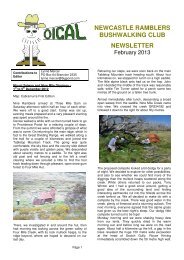Cold Weather Clothing - University of Manitoba
Cold Weather Clothing - University of Manitoba
Cold Weather Clothing - University of Manitoba
- No tags were found...
You also want an ePaper? Increase the reach of your titles
YUMPU automatically turns print PDFs into web optimized ePapers that Google loves.
horizontal as possible. This willincrease the amount that can be putinto the pocket and minimize thepossibility <strong>of</strong> contents falling outrespectively.Zippers must be able to beOPERATED WITH MITTS ON. Thiscan be greatly assisted byattachment <strong>of</strong> 5-8 cm (2-3”) tabs toEACH zipper on a garment. Again,fashion concerns dictate that zippersbe small and inconspicuous.Unfortunately, all things beingequal, small zippers ‘catch’ or ‘snag’more <strong>of</strong>ten and are more prone tobreaking. They are alsoconsiderably more difficult tooperate, even with the tabs.c) Length and overall coverage.One major weakness in a clothingensemble is <strong>of</strong>ten the decreasedthermal insulation at the waist. It isimportant that upper and lowerbody garments either arecontinuous (one piece or attached)or overlapping. It is important t<strong>of</strong>orgo the fashionable short jacketfor a longer model that will overlapyour pants and protect your seatwhile you are sitting. Extraprotection can also be gained byswitching from a normal pant to abib design for the outer layer.d) Ventilation. It is EXTREMELYimportant to be able to ventilate aclothing ensemble while it is beingused. Two main functions <strong>of</strong>clothing ventilation are: 1) removal<strong>of</strong> water vapor from inside theensemble; and 2) to allowconvective, conductive, evaporativeand even radiative heat loss fromthe skin surface. Ventilation may befacilitated by opening sleeve ends,‘pit zips’ and the front zipper (whichis a reason not to use a solid frontpullover design). The ‘pit zips’should be long enough to actuallyallow the arms to be placed throughthem, if the need to increaseradiative and convective heat lossfrom the arms occurs.STRATEGIES FOR USING CLOTHING1) Layering design. The clothingensemble should have several layersinstead <strong>of</strong> one large thick layer. Thisprovides the obvious advantage <strong>of</strong>fine-tuning or adjusting the thermalinsulation value in order to adjust towarmer or colder conditions. Inaddition, each layer should also bechosen to perform specific tasks.a) Inner layer. It is commonknowledge that the inner layer(usually polyester) should be highlyvapor permeable so that moisture istransferred or ‘wicked’ away fromthe skin through to the next layers<strong>of</strong> clothing. Having dry skin greatlyincreases one’s comfort level.b) Middle layer(s). The middlelayer(s) are mainly for insulationand can be fleece, pile, wool or eventhicker polyester. It should bereemphasized that this middle zoneshould comprise multiple insulativelayers rather than one thicker layer.c) Outer layer. The main function<strong>of</strong> this layer is to provide windand/or moisture protection,depending on the prevailingconditions. Various materials canbe used including Gortex, 60/40cloth, cordura, windstopper (PTFElaminate), nylon, and others.2) Layering Strategy. As stated above, itis important that a clothing ensemble<strong>Cold</strong> <strong>Weather</strong> <strong>Clothing</strong> 4 Gordon Giesbrecht
















